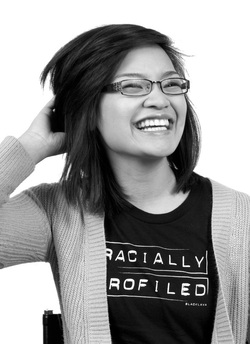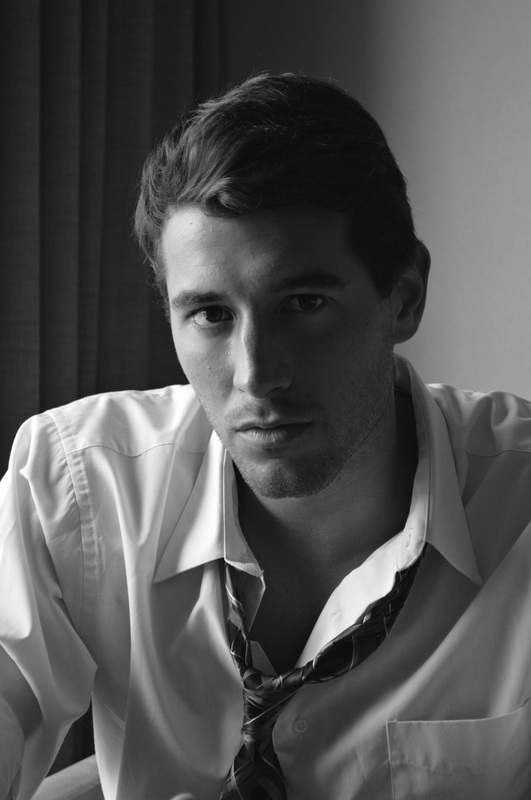By Jorge G. Zavala
Creative Director
Creative Director

May in the United States is Asian Pacific American Heritage Month (APAHM). It is a celebration of the culture, traditions, and history of Asian-Americans and Pacific Islanders in the United States. Congress passed a joint Congressional Resolution in 1978 to commemorate Asian American Heritage Week during the first week of May. This date was chosen because two important anniversaries occurred during this time: the arrival of the first Japanese immigrants in the United States on May 7, 1843 and the completion of the transcontinental railroad (by many Chinese laborers) on May 10, 1869. In 1990 Congress voted to expand it from a week to a month long celebration and in May 1992, the month of May was permanently designated as Asian/Pacific American Heritage Month.
In honor of APAHM, Le Prestige conducted an interview with Chicago's very own Carla Navoa, "agitator extraordinaire" as she calls herself, to discuss her work and experience with the Asian-American community, her thoughts regarding immigration, and the "model minority" label.
1) What is the name of your organization and what is your role within it?
I work as a youth organizer at the Korean American Resource and Cultural Center (KRCC). I work closely with KRCC’s youth-led organizing council FYSH, Fighting Youth Shouting Out for Humanity, which provides a space to educate and empower young people who are passionate about creating change in their community.
2) In your opinion, what are some of the key issues important to the Asian American community you work with? What are their needs and wants?
One of the things I’m highly invested in working toward, of course, is immigration reform. As an undocumented immigrant, I understand my own struggles and my family's struggles. I cannot speak for anyone else other than myself, but I do see commonalities that connect my experiences with other undocumented young people.
Undocumented youth want to be able to attain higher education, to work, to be recognized as citizens of the country we contribute to everyday and consider home, and to access the rights we deserve.
For undocumented Asian Americans, many are very fearful of “coming out” and speaking publicly about their status for many reasons. In my experience, I know my family does not want others to know of our hardships; we refuse to be pitied. I think this frame of mind comes from our culture. But by sharing my story and taking the risk of putting myself in a vulnerable position, I am able to put a human face to the issue.
Since not many undocumented Asian Pacific-Islander Americans (APIA) come out publicly and take on leadership roles in the immigrants rights movement, the lack of visibility, I think, hinders more of us from participating and empowering ourselves. I see the need to create spaces for undocumented APIAs to connect with one another and work through the social stigma in our community and the shame many of us have internalized. Not only do undocumented APIAs bear the weight of society’s expectation to live up to the “model minority” standard, being undocumented places an even greater strain on one’s mental health and self-esteem. Therefore, I truly believe that a space to build community and a network of support makes all the difference. It has for me.
3) May is Asian Pacific American Heritage Month across the United States. Do you participate, individually or with your organization, in any events specific to empowering the APIA community?
Over the past couple of months, I began working with folks from Bayan-USA and Anakbayan to help coordinate the Anakbayan-USA Founding Congress that happened here in Chicago during the recent NATO summit. Anakbayan-USA is a national Filipino youth organization that works to empower, organize, and mobilize young people to fight for true democracy in the Philippines and stand up against US imperialism. Although this event does not directly connect to the city’s Asian Heritage Month celebrations, the Congress will serve as an opportunity to build political consciousness in the Filipino-American community.
I feel that this Congress is important to my work as an advocate for immigrants’ rights because the Filipino-American community is highly affected by America’s broken immigration system. According to the Department of Homeland Security, there were an estimated 280,000 undocumented Filipinos living in the U.S. in 2010. Unfortunately, undocumented Filipinos (or TNTs) are still very afraid to take action. Also, there aren’t many young Filipinos in Chicago who carry out social justice work. I feel like this is a chance for me to connect with other radical and progressive Filipino organizers from all over the country who can support my work and reconnect me with my roots.
In honor of APAHM, Le Prestige conducted an interview with Chicago's very own Carla Navoa, "agitator extraordinaire" as she calls herself, to discuss her work and experience with the Asian-American community, her thoughts regarding immigration, and the "model minority" label.
1) What is the name of your organization and what is your role within it?
I work as a youth organizer at the Korean American Resource and Cultural Center (KRCC). I work closely with KRCC’s youth-led organizing council FYSH, Fighting Youth Shouting Out for Humanity, which provides a space to educate and empower young people who are passionate about creating change in their community.
2) In your opinion, what are some of the key issues important to the Asian American community you work with? What are their needs and wants?
One of the things I’m highly invested in working toward, of course, is immigration reform. As an undocumented immigrant, I understand my own struggles and my family's struggles. I cannot speak for anyone else other than myself, but I do see commonalities that connect my experiences with other undocumented young people.
Undocumented youth want to be able to attain higher education, to work, to be recognized as citizens of the country we contribute to everyday and consider home, and to access the rights we deserve.
For undocumented Asian Americans, many are very fearful of “coming out” and speaking publicly about their status for many reasons. In my experience, I know my family does not want others to know of our hardships; we refuse to be pitied. I think this frame of mind comes from our culture. But by sharing my story and taking the risk of putting myself in a vulnerable position, I am able to put a human face to the issue.
Since not many undocumented Asian Pacific-Islander Americans (APIA) come out publicly and take on leadership roles in the immigrants rights movement, the lack of visibility, I think, hinders more of us from participating and empowering ourselves. I see the need to create spaces for undocumented APIAs to connect with one another and work through the social stigma in our community and the shame many of us have internalized. Not only do undocumented APIAs bear the weight of society’s expectation to live up to the “model minority” standard, being undocumented places an even greater strain on one’s mental health and self-esteem. Therefore, I truly believe that a space to build community and a network of support makes all the difference. It has for me.
3) May is Asian Pacific American Heritage Month across the United States. Do you participate, individually or with your organization, in any events specific to empowering the APIA community?
Over the past couple of months, I began working with folks from Bayan-USA and Anakbayan to help coordinate the Anakbayan-USA Founding Congress that happened here in Chicago during the recent NATO summit. Anakbayan-USA is a national Filipino youth organization that works to empower, organize, and mobilize young people to fight for true democracy in the Philippines and stand up against US imperialism. Although this event does not directly connect to the city’s Asian Heritage Month celebrations, the Congress will serve as an opportunity to build political consciousness in the Filipino-American community.
I feel that this Congress is important to my work as an advocate for immigrants’ rights because the Filipino-American community is highly affected by America’s broken immigration system. According to the Department of Homeland Security, there were an estimated 280,000 undocumented Filipinos living in the U.S. in 2010. Unfortunately, undocumented Filipinos (or TNTs) are still very afraid to take action. Also, there aren’t many young Filipinos in Chicago who carry out social justice work. I feel like this is a chance for me to connect with other radical and progressive Filipino organizers from all over the country who can support my work and reconnect me with my roots.

Photo credit: Inside/Out Project
4) What is the first thing you think of when you hear "illegal"?
Drop the I-word.
5) Immigration is a trending topic both in the media and in the lives of many Americans. What sorts of issues that you are aware of do Asian and Pacific Islander Americans (APIA) encounter with regards to immigration and barriers?
For Filipinos, the wait to attain a visa to immigrate to the U.S. can take up to 20 years. People cannot simply “wait in line” if they want to reunite with their families or to find greater economic opportunities. For many Asian Americans who come to the U.S. on student visas and decide to stay, they find themselves unable to gain legal status and become undocumented. Same goes for professionals who come on work visas and lose their jobs. It’s very easy to become undocumented if you’re not a citizen.
6) Many of us have heard Asian-Americans being considered the "model minority". What does this term mean and how do you see it as having both negative and positive connotations? Is it a term that hits home?
The model minority myth projects an image of Asian Americans as the “good” immigrant people who are self-made, educated, high-achieving, politically compliant, and a whole slew of other fallacies meant to create divisions between Asians (deemed “honorary whites”) and people of color. It’s a stereotype meant to cast down other people of color and blame individuals for their failure to overcome institutional barriers. Yes, many Asian American have gained economic success, but many also live below poverty level and graduate from high school at similar rates to Latinos and Blacks. The model minority myth does not extend to Pacific Islanders who largely lack visibility in the public imagination. Obviously, the model minority myth does more harm than good to our communities.
7) In your opinion, why do we need an Asian Pacific American Heritage Month? What are some of the contributions the APIA community has made to Chicago? What are some of the issues the community(ies) you work with encounter?
APIAs are unrepresented on many levels in society, from mainstream popular culture up to the political sphere. But APIAs played a vital role in this country’s history, which often receives little to no recognition. Advocacy organizations continue to fight for political representation, community-based organizations work to empower young people to serve as leaders, and educators shed light on the untold history and struggles of my people. I think Asian American Heritage Month is the least this country can do to recognize the importance of APIA communities’ contributions.
8) As someone who works across communities, what are some similarities you've encountered between the Asian Pacific-Islander American and Latino communities? What are some of the differences?
In terms of immigrant rights work, I find both communities understand the urgency of needing to push for immigration reform, but since Obama’s announcement on prosecutorial discretion I find a lot of organizations with a large base of Latino immigrants focus on PD as well as attacking detention centers and deportations. Whenever I hear of Asian-American families who have been placed in removal proceedings, they often leave voluntarily. I also see many families more willing to self-deport. Therefore, if there aren’t many APIAs faced with deportation who stand up to fight the law, then the advocacy organization cannot act separately from the community. I think the differences in focus makes sense since the majority of those currently in detention centers are Latinos.
Another thing I find problematic at times is the recent rhetoric around building “black-brown” solidarity on the issue of detention centers and the prison industrial complex as a way to strengthen alliances between communities fighting for immigrant rights and human rights. Sometimes I feel excluded as an Asian-American (even though I am brown, but many of my Asian friends would be considered “yellow”). Racial categories are constructed, but I still see a need to create more inclusive language in solidarity discourse.
Carla Navoa is a senior at the University of Illinois at Chicago studying English and Asian-American Studies. As an undocumented student and immigrants' rights advocate, Carla works as youth organizer at the Korean American Resource and Cultural Center where she coordinates after-school programs and KRCC's youth-led organizing council, Fighting Youth Shouting Out for Humanity (FYSH). FYSH works to empower immigrant youth to become leaders through art-making, cultural performance, community organizing, and civic participation.
Drop the I-word.
5) Immigration is a trending topic both in the media and in the lives of many Americans. What sorts of issues that you are aware of do Asian and Pacific Islander Americans (APIA) encounter with regards to immigration and barriers?
For Filipinos, the wait to attain a visa to immigrate to the U.S. can take up to 20 years. People cannot simply “wait in line” if they want to reunite with their families or to find greater economic opportunities. For many Asian Americans who come to the U.S. on student visas and decide to stay, they find themselves unable to gain legal status and become undocumented. Same goes for professionals who come on work visas and lose their jobs. It’s very easy to become undocumented if you’re not a citizen.
6) Many of us have heard Asian-Americans being considered the "model minority". What does this term mean and how do you see it as having both negative and positive connotations? Is it a term that hits home?
The model minority myth projects an image of Asian Americans as the “good” immigrant people who are self-made, educated, high-achieving, politically compliant, and a whole slew of other fallacies meant to create divisions between Asians (deemed “honorary whites”) and people of color. It’s a stereotype meant to cast down other people of color and blame individuals for their failure to overcome institutional barriers. Yes, many Asian American have gained economic success, but many also live below poverty level and graduate from high school at similar rates to Latinos and Blacks. The model minority myth does not extend to Pacific Islanders who largely lack visibility in the public imagination. Obviously, the model minority myth does more harm than good to our communities.
7) In your opinion, why do we need an Asian Pacific American Heritage Month? What are some of the contributions the APIA community has made to Chicago? What are some of the issues the community(ies) you work with encounter?
APIAs are unrepresented on many levels in society, from mainstream popular culture up to the political sphere. But APIAs played a vital role in this country’s history, which often receives little to no recognition. Advocacy organizations continue to fight for political representation, community-based organizations work to empower young people to serve as leaders, and educators shed light on the untold history and struggles of my people. I think Asian American Heritage Month is the least this country can do to recognize the importance of APIA communities’ contributions.
8) As someone who works across communities, what are some similarities you've encountered between the Asian Pacific-Islander American and Latino communities? What are some of the differences?
In terms of immigrant rights work, I find both communities understand the urgency of needing to push for immigration reform, but since Obama’s announcement on prosecutorial discretion I find a lot of organizations with a large base of Latino immigrants focus on PD as well as attacking detention centers and deportations. Whenever I hear of Asian-American families who have been placed in removal proceedings, they often leave voluntarily. I also see many families more willing to self-deport. Therefore, if there aren’t many APIAs faced with deportation who stand up to fight the law, then the advocacy organization cannot act separately from the community. I think the differences in focus makes sense since the majority of those currently in detention centers are Latinos.
Another thing I find problematic at times is the recent rhetoric around building “black-brown” solidarity on the issue of detention centers and the prison industrial complex as a way to strengthen alliances between communities fighting for immigrant rights and human rights. Sometimes I feel excluded as an Asian-American (even though I am brown, but many of my Asian friends would be considered “yellow”). Racial categories are constructed, but I still see a need to create more inclusive language in solidarity discourse.
Carla Navoa is a senior at the University of Illinois at Chicago studying English and Asian-American Studies. As an undocumented student and immigrants' rights advocate, Carla works as youth organizer at the Korean American Resource and Cultural Center where she coordinates after-school programs and KRCC's youth-led organizing council, Fighting Youth Shouting Out for Humanity (FYSH). FYSH works to empower immigrant youth to become leaders through art-making, cultural performance, community organizing, and civic participation.

 RSS Feed
RSS Feed


